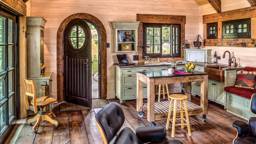
Most people choose a log cabin because they like the look. To achieve the right look, log cabin owners must make design choices that affect not only the look but also the cost of the cabin. Consider the four S’s to get you started.
See also Understanding the Idiosyncrasies of Log Homes
Log Cabin Style
Let’s face it: The way your cabin will look when it’s done is priority No. 1. And since most log companies specialize in particular styles of fabrication, the process of elimination should start with the style of log you prefer. Log home producers fall into two general categories: manufacturers and handcrafters. Both create beautiful, weathertight log homes, but the methods they use to craft their logs diverge and, therefore, their homes look vastly different.
Manufactured log homes make up the majority of the market (about 90%). These logs are milled to a specific “profile” (or shape) and tend to have smooth surfaces (though some do offer a rougher hewn look) and a uniform diameter from end to end. Because the work is done by machine, milled log homes can be cut and assembled quickly.
Handcrafted log homes represent a significantly smaller portion of the log home marketplace. Due to the labor and craftsmanship involved (these logs are hand-hewn for a textured finish), each home is more time consuming to produce and, thus, more expensive. Knotty character logs with one-of-a-kind bumps and distinguishing markings are hallmarks of handcrafted log homes. They also can be accents (columns, trusses, staircases) in a milled log home.
See also Selecting a Log Home Builder
Log Species
Many buyers set out to find which company uses the best tree species, only to discover this is more elusive than the Holy Grail. Truth is, there isn’t a single best species for log home construction. Log homes of varying species have been standing for centuries, and with modern wood-care preservatives, almost all logs have excellent tolerance against insects, decay and other natural enemies. Our advice is to go with your gut – choose a species that you find aesthetically pleasing and that’s available from your favorite providers. Certainly ask a rep of each company that you’re considering: What species do you recommend and why?

Log Cabin Systems
Today’s modern log homes involve various building systems that combine engineering principles with specific crafting, fastening and weatherproofing techniques. Ask companies if their building systems are recognized by your local building codes. Will an engineer’s stamp be required for approval and, if so, at what cost? Here are the log systems available today: Full-log homes are what most people envision when you say the words “log home.” Here, the process involves solid timbers cut to your desired profile. The architect or designer who creates your construction documents will specify how far apart fasteners should be between log courses. Fasteners include spikes, screws, drift pins and bolts, and they’re usually included in the log home package. Your producer may offer more than one fastening option or use more than one type on the same walldepending on its structural needs, the locations of the windows and doors and the type of wood species you select. When considering your options, understand that no single fastener is superior to another, but it’s imperative that your builder follows the fastener schedule exactly as outlined for maximum wall stability.
Half-log homes are conventionally built with 2x4- or 2x6-stud framing. Split logs or half-log siding is then applied inside and out. Corners generally have a full-log appearance to perpetuate the traditional log home feeling. Often, buyers of full-log homes will include a little half-log construction (say, for a gable dormer or garage) to save money on materials and labor.
Hybrid homes combine logs with other building materials, including timber framing.
See also Different Types of Cabins
What is Shrinkage?
Here’s the science behind shrinkage: After a tree is felled, the moisture content drops, cells collapse and the log shrinks. Eventually, the moisture level reaches equilibrium with its environment, indicating the end of the shrinkage process. Because of this, log home producers must account for shrinkage and wood movement during the design and construction of their homes. Log home producers have learned to compensate for shrinkage, typically allowing logs to air dry on their own or forcing the moisture out by drying the logs in a kiln. Neither process is better than the other; however, kiln drying is faster and eradicates any insects that may be trying to make your logs their home. Kiln drying is rarely an option for handcrafters who work with long, thick logs, and few people are willing to wait for these massive timbers to air dry. As a result, handcrafters who use fresh wood have devised construction techniques to compensate for the dimensional changes that occur as logs shrink.










